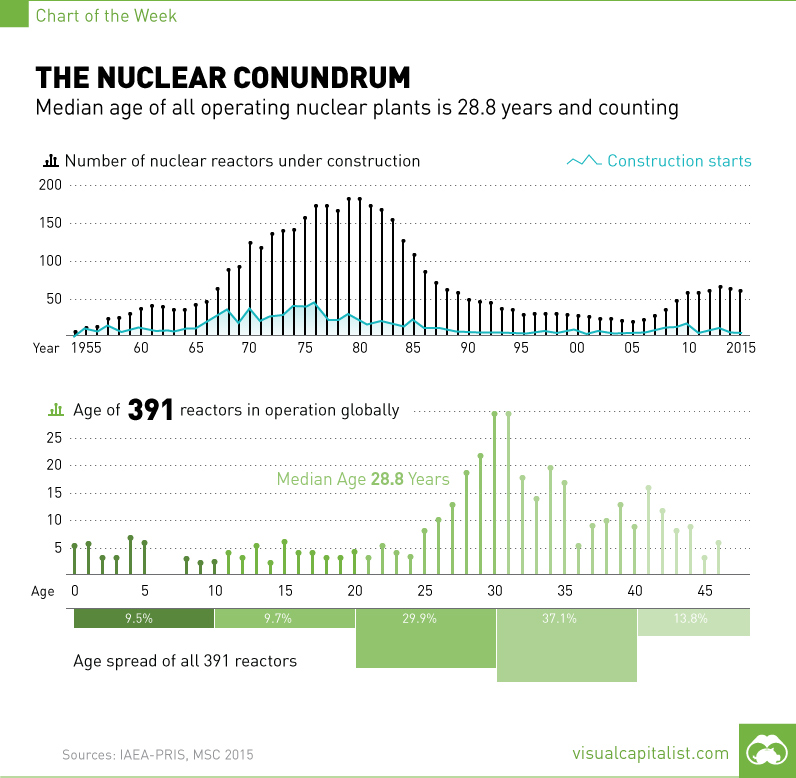The Nuclear Conundrum [Chart]
Median age of all operating nuclear reactors is 28.8 years and counting.
The Chart of the Week is a weekly Visual Capitalist feature on Fridays. The nuclear sector today certainly has its immediate challenges. Costs had already been a long problem, but the incident at Fukushima complicated matters even further. The industry and regulators were forced to take a second look at its safety practices and plant designs, creating uncertainty for the sector. As of today, 2006 still remains a peak for global nuclear power generation in terms of total output, and it has steadily declined since then. There is also another creeping issue for the industry that is raising eyebrows. According to The World Nuclear Report, there are 391 nuclear reactors in operation throughout the world. However, the median age of these reactors is now 28.8 years, due to the majority of power plants being built between 1970 and 1985. The design specifications for most nuclear reactors envision an operating lifespan of 30 to 40 years. In the U.S. specifically, nuclear utilities are initially licensed for 40 years. Near the end of that initial timeframe, they can apply for an additional 20 years. While there are many experts who believe that older reactors are not a problem, it is hard to imagine many families feeling safe living next to aging nuclear reactors. Furthermore, with recent evens, even more questions have surfaced about the wisdom of keeping aging reactors plugged into the grid. The Fukushima Daiichi units (1 to 4) were first commissioned between 1971 and 1974, and the license for the first unit had been extended for another 10 years in February 2011. This was just a month before the disaster took place. Right now, most operators are doing what they can to extend the life of their reactors. However, at some point it won’t be enough. This brings us to a challenging fork in the road: will we move forward with a fleet of aging reactors, or will we bite the bullet to build new ones? If we decommission them without replacement, how will that power supply be replaced? on Today’s chart measures the extent to which 41 major economies are reopening, by plotting two metrics for each country: the mobility rate and the COVID-19 recovery rate: Data for the first measure comes from Google’s COVID-19 Community Mobility Reports, which relies on aggregated, anonymous location history data from individuals. Note that China does not show up in the graphic as the government bans Google services. COVID-19 recovery rates rely on values from CoronaTracker, using aggregated information from multiple global and governmental databases such as WHO and CDC.
Reopening Economies, One Step at a Time
In general, the higher the mobility rate, the more economic activity this signifies. In most cases, mobility rate also correlates with a higher rate of recovered people in the population. Here’s how these countries fare based on the above metrics. Mobility data as of May 21, 2020 (Latest available). COVID-19 case data as of May 29, 2020. In the main scatterplot visualization, we’ve taken things a step further, assigning these countries into four distinct quadrants:
1. High Mobility, High Recovery
High recovery rates are resulting in lifted restrictions for countries in this quadrant, and people are steadily returning to work. New Zealand has earned praise for its early and effective pandemic response, allowing it to curtail the total number of cases. This has resulted in a 98% recovery rate, the highest of all countries. After almost 50 days of lockdown, the government is recommending a flexible four-day work week to boost the economy back up.
2. High Mobility, Low Recovery
Despite low COVID-19 related recoveries, mobility rates of countries in this quadrant remain higher than average. Some countries have loosened lockdown measures, while others did not have strict measures in place to begin with. Brazil is an interesting case study to consider here. After deferring lockdown decisions to state and local levels, the country is now averaging the highest number of daily cases out of any country. On May 28th, for example, the country had 24,151 new cases and 1,067 new deaths.
3. Low Mobility, High Recovery
Countries in this quadrant are playing it safe, and holding off on reopening their economies until the population has fully recovered. Italy, the once-epicenter for the crisis in Europe is understandably wary of cases rising back up to critical levels. As a result, it has opted to keep its activity to a minimum to try and boost the 65% recovery rate, even as it slowly emerges from over 10 weeks of lockdown.
4. Low Mobility, Low Recovery
Last but not least, people in these countries are cautiously remaining indoors as their governments continue to work on crisis response. With a low 0.05% recovery rate, the United Kingdom has no immediate plans to reopen. A two-week lag time in reporting discharged patients from NHS services may also be contributing to this low number. Although new cases are leveling off, the country has the highest coronavirus-caused death toll across Europe. The U.S. also sits in this quadrant with over 1.7 million cases and counting. Recently, some states have opted to ease restrictions on social and business activity, which could potentially result in case numbers climbing back up. Over in Sweden, a controversial herd immunity strategy meant that the country continued business as usual amid the rest of Europe’s heightened regulations. Sweden’s COVID-19 recovery rate sits at only 13.9%, and the country’s -93% mobility rate implies that people have been taking their own precautions.
COVID-19’s Impact on the Future
It’s important to note that a “second wave” of new cases could upend plans to reopen economies. As countries reckon with these competing risks of health and economic activity, there is no clear answer around the right path to take. COVID-19 is a catalyst for an entirely different future, but interestingly, it’s one that has been in the works for a while. —Carmen Reinhart, incoming Chief Economist for the World Bank Will there be any chance of returning to “normal” as we know it?













